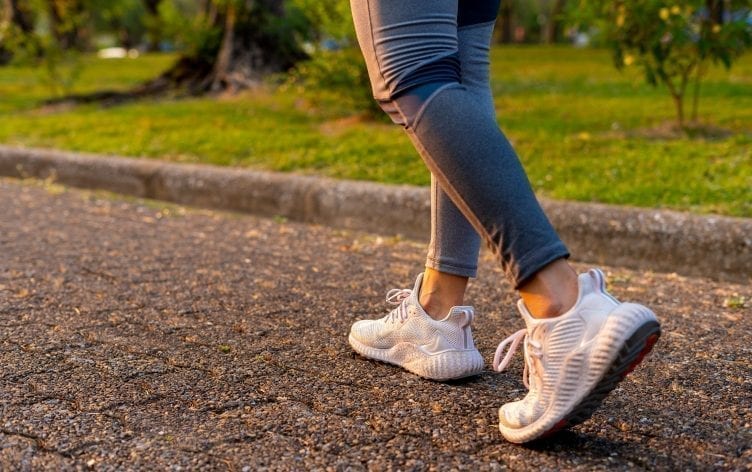
Even though walking is generally a safe, low-impact activity, injuries still occur as you start to bump up your miles and speed. For many walkers, overuse injuries to the foot and ankle are most common, as the pressure placed in these areas during toe-off can create problems. And, like with most injuries involving the lower extremities, footwear can play a big role in preventing and resolving some of these issues.
Rocker-bottom shoes have increased in popularity in the last several years, promising to help prevent some of these common injuries by making the walking motion more efficient, and allowing you to walk longer with less effort. Let’s take a look at a few recent studies to see if making the switch to rocker-bottom walking shoes could be the right choice for you.
THE STUDIES
The injuries walkers face most often include plantar fasciitis, Achilles’ tendonitis and inflammation or pain near the big toe joint (MTP). To address these problems, most major walking and running shoe manufacturers have created models with a rocker-bottom sole to relieve some of these issues. But do they actually work?
Several recent studies have looked into these designs to see if they are more beneficial in reducing injury risk and increasing efficiency compared to more traditionally designed running and walking shoes. And, like most controversial topics, results on the subject are somewhat mixed.
This 2017 study favored the rocker-sole design for those looking to reduce plantar flexion during the gait cycle, which can help relieve stress on the Achilles tendon during toe-off. While it was noted in the results that these designs can be useful in dealing with heel pain, they also stated that “greater plantar-flexion forces were seen in rocker-soled shoes with softer material than with denser material.” So, while a rocker-sole shoe could be beneficial when dealing with recurring Achilles issues, all shoes are not created equal, and attention needs to be focused on the firmness of the midsole.
Still, rocker-bottom shoes are one of the most commonly prescribed external therapeutic shoe modifications among podiatrists for good reason. In fact, this study demonstrated the combination of rocker-soled shoes and orthotics inserts produced the greatest immediate therapeutic effects on plantar fasciitis.
For anyone suffering with osteoarthritis of the first metatarsophalangeal (MTP) joint, an issue that can occur as we age, this 2016 study shows how rocker-soled footwear and orthotics could also be beneficial for reducing foot pain.
But, like with anything else, there are drawbacks to the technology. A 2014 study found walkers who suffer from balance and stability issues could be further affected by wearing this type of footwear. And for those who suffer from obesity, rocker-sole shoes might even increase heel pain in individuals with low arches. In these cases, it seems one size doesn’t fit all.
HOW ROCKER-BOTTOM SOLES CAN HELP
With so many different studies to sift through, it can be hard to determine if an option like rocker-bottom shoes could actually work for you. Like with anything else, this type of footwear is highly individual. What might work for some might not work for others. Per the aforementioned studies, if you suffer from obesity and have low arches, or are an older walker dealing with balance or stability issues, rocker-sole walking shoes aren’t ideal.
On the other hand, if you can’t seem to shake common walking injuries like Achilles’ tendonitis, plantar fasciitis or you have pain in the MTP joint from osteoarthritis, trying a rocker-sole shoe is in line with most podiatrists’ recommendations. Dr. Larry Huppin of the Foot & Ankle Center of Washington agrees.
“A lot of people have pain, even with orthotics,” he says. “And a lot of that is because when they walk forward, they’re putting a lot of pressure on the ball of the foot, and the big toe joint is asked to bend a lot. Rocker-sole shoes are completely rigid on the front, and because they don’t bend when you step, you’re not being asked to bend the big toe joint. This helps transfer pressure off the ball of the foot to a part of the foot that is less painful.”
If you’re on the fence about whether or not these shoes would help a current injury, it’s always best to visit a medical professional first. On the other hand, if you have dealt with these types of injuries in the past and are looking to prevent future occurrences, a rocker-sole walking shoe could be worth trying.
ROCKER-SOLE WALKING SHOE OPTIONS
If you’re looking for a few rocker-sole options to walk in, there are plenty of models on the market with a variety of features that could help to make your stride more efficient and your body less injury-prone. Here are a few options to consider:
- Gravity Defyer G-Defy ($135): This front-rocker is a favorite for plantar fasciitis and low-back pain. It comes with a free orthotic to individualize your alignment.
- Altra Torin 4.5 Plush ($140): If you want something with a little more cushion for pain at the front of the foot, this is a top option. Altra designs are known for their wider forefoot, allowing for a more natural toe splay. Keep in mind, these shoes are zero drop (same height in the forefoot and heel), so they’re not an option for those with Achilles’ tendonitis.
- Hoka Bondi ($150): Known for its max-cushion options, Hoka might be a good choice if you suffer from heel or Achilles pain. We like this option for its overall comfort, but the company offers several different walking shoes with rocker designs.
Make progress every day while you work on mini fitness and nutrition goals, like walking more steps or learning to track macros. Go to “Plans” in the MyFitnessPal app for daily coaching and easy-to-follow tasks to keep you motivated.





